Learn about the tropical fruits of Brazil that you must try (at least) once in your life.
Brazil is a warm country known for having favorable weather conditions for the growth of crops.
That’s one of the reasons my Dutch husband was positively surprised when he saw an avocado and a passion fruit in the local market. He said they were massive compared to the ones found in the Netherlands.
Our fruits are not only considerably big, but they’re usually juicy and sweet.
And since Brazilian food is a serious business in the country, I thought I could share a little about our fruits too.
Most of these Brazilian fruits are best-known in the regions where they are produced or where they occur naturally as wild fruit.
That’s because most of the fruits I’ll mention here are not produced on a large scale, meaning when they hit markets and fairs, their prices are much higher than the prices of other common fruits.
Not enough time to read this article in one sitting? Then save it for later!
Fun fact: We Brazilians eat avocado with sugar! Like the idea? You might want to try this Brazilian avocado smoothie, then!
Brazilian fruits
Fruits originally from Brazil usually have a sweet flavor and unique shape.
For most Americans and Europeans, most of these fruits of Brazil might be completely new.
For instance, my Dutch husband only knew three of the fruits I mention below.
Unlike popular belief, lychee, kiwi, star fruit, and pitaya are not Brazilian fruits. However, they’re good examples of foods from tropical regions – colorful and in all shapes.
Wanna learn more about Brazilian fruits? Read on!
Health benefits of Brazilian fruits
In the grocery shop and market, we always find the same kinds of fruits – banana, apple, orange, mango, and a few others grown by small scale depending on the season.
Naturally, we should always be careful when consuming new fruits or plants we don’t know to avoid food poisoning.
Still, it’s interesting to learn about other fruits rich in several vitamins and minerals that you could include in your diet.
So to give you an idea of top Brazilian fruits, those that are originally from our land, I decided to write this article to you.
I hope I can make you curious enough so that you’ll try these fruits when visiting Brazil.
Top 15 fruits of Brazil
Naturally, I could include loads of other foods to this list of Brazilian fruits, but I chose the top 15 ones in the country.
Siriguela (Spondias purpurea)
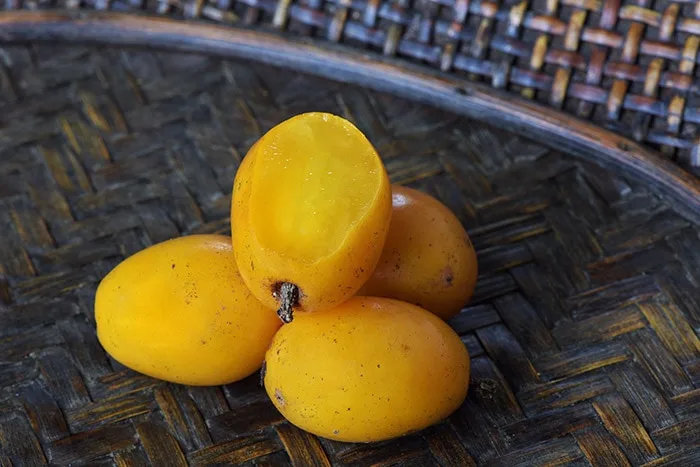
Pronunciation: see-ree-gweh-lah
This plant is a species in the cashew family. Ciriguela is rich in vitamins A, B, and C, and minerals like calcium, phosphorus, and iron.
The siriguela has powerful antioxidant and antiaging properties. This fruit is common in the desert and savanna region of Brazil.
Abiu (Pouteria caimito)
Pronunciation: ah-bee-uh
Abiu is a tree that originated in the Amazon region. Still, today can be found in many tropical areas, such as Hawaii.
This Brazilian fruit is rich in vitamin A, calcium, and phosphorus. While abiu resembles a lemon, its flesh is very sweet.
Abiu is famous for its therapeutic properties and is perfect for boosting the immune system.
Jenipapo (Genipa)
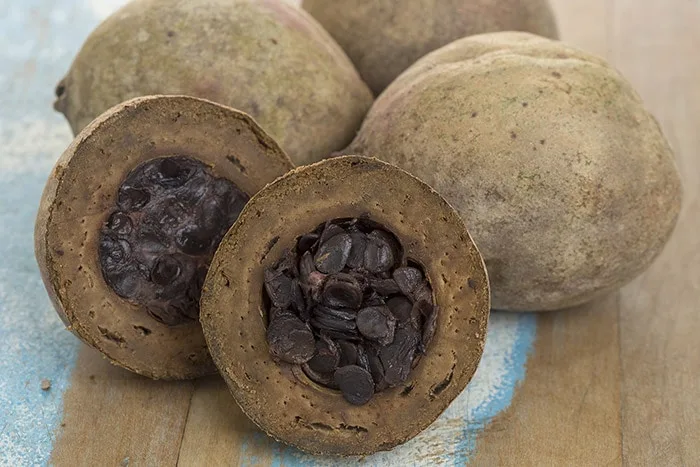
Pronunciation: jeh-nee-pah-poh
Jenipapo can be found in different biomes in Brazil. Still, it’s more abundant in the north and northeast of the country.
It doesn’t come as a surprise that this plant belongs to the coffee family. Jenipapo resembles a fig, but it’s twice as big as one, and it tastes sweet but slightly acid.
We Brazilian don’t eat the fruit because it smells a bit weird. Still, jenipapo is widely used to produce delicious liquors, syrups, and juices.
This Brazilian fruit is rich in vitamin C and B and iron, and calcium.
Fun fact: from the top 20 most consumed fruits in Brazil, only two are native – pineapple (8th) and passion fruit (13th).
Mandacaru (Cereus jamacaru)
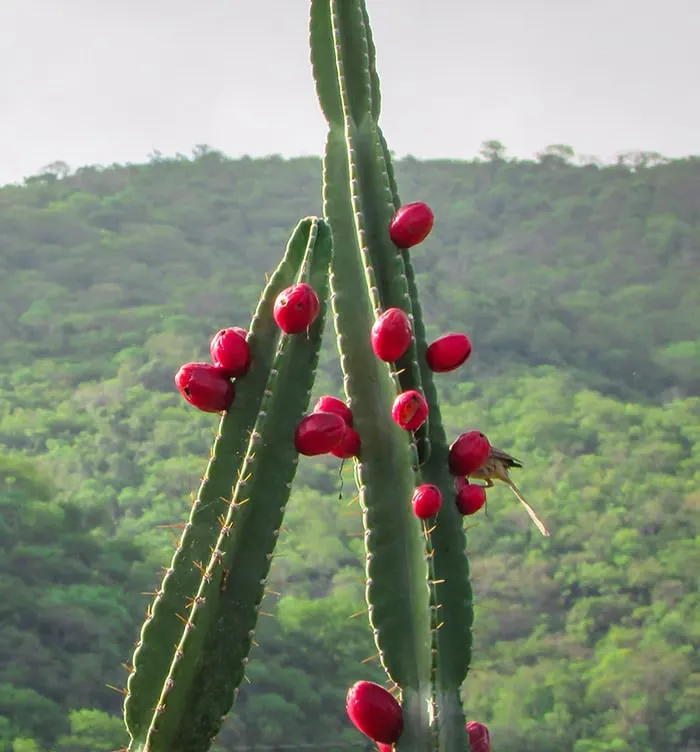
Pronunciation: mahn-dah-kah-ruh
This cactus is common in the northeast and grows up to 20ft (5m) high.
Mandacaru is an evergreen plant that provides a pink fruit with white flesh.
Rich in starch, this fruit is slightly sweet in flavor and can be as big as an apple.
Mandacaru is rich in water, sodium, magnesium, and phosphorus.
Guarana (Paullinia cupana)
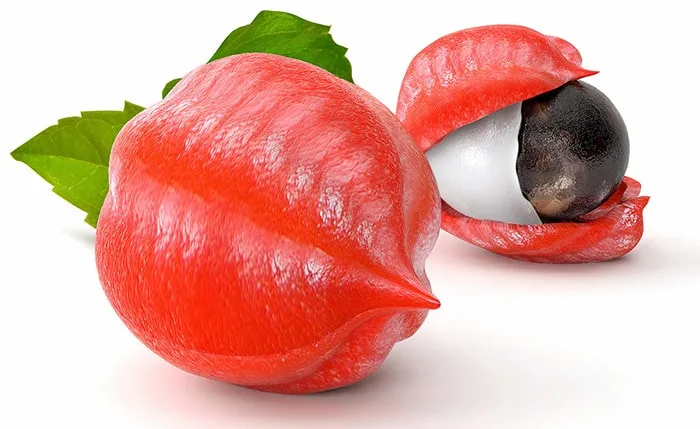
Pronunciation: gwah-rah-nah
Native to the Amazon basin, guarana is a climbing plant in the family Sapindaceae.
Guarana is a fruit famous for its stimulant effect. It contains twice the concentration of caffeine found in coffee seeds, that’s why it’s widely used in energy drinks.
The fruit has this name because of its similarities with an eyeball. In the Brazilian Indigenous people’s language, Guarana means “fruit like the eyes of the people.”
Cambuci (Campomanesia phaea)
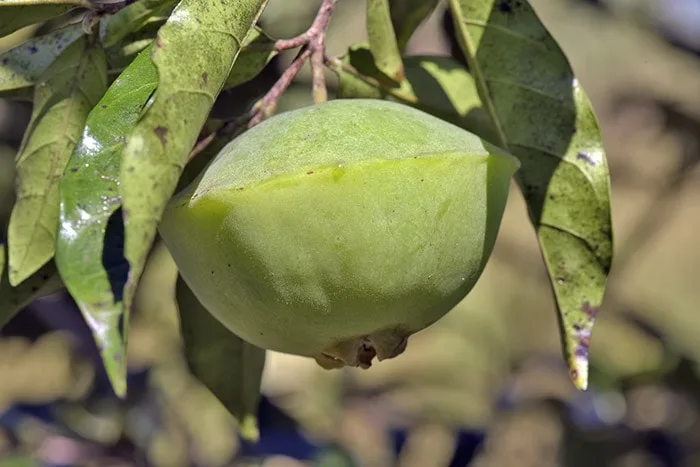
Pronunciation: kahm-buh-see
Cambuci belongs to the family of guava and pitanga, other fruits from Brazil.
More popular in the southeast region, Cambuci is more common in the Atlantic Forest and even became a neighborhood in the city of São Paulo because of its popularity back in the day.
This tree is massive and has not only beautiful white flowers but also a flying saucer-shaped fruit.
The cambuci fruit is rich in vitamin C and antioxidants and has a sour taste like a lime.
Cupuaçu (Theobroma grandiflorum)
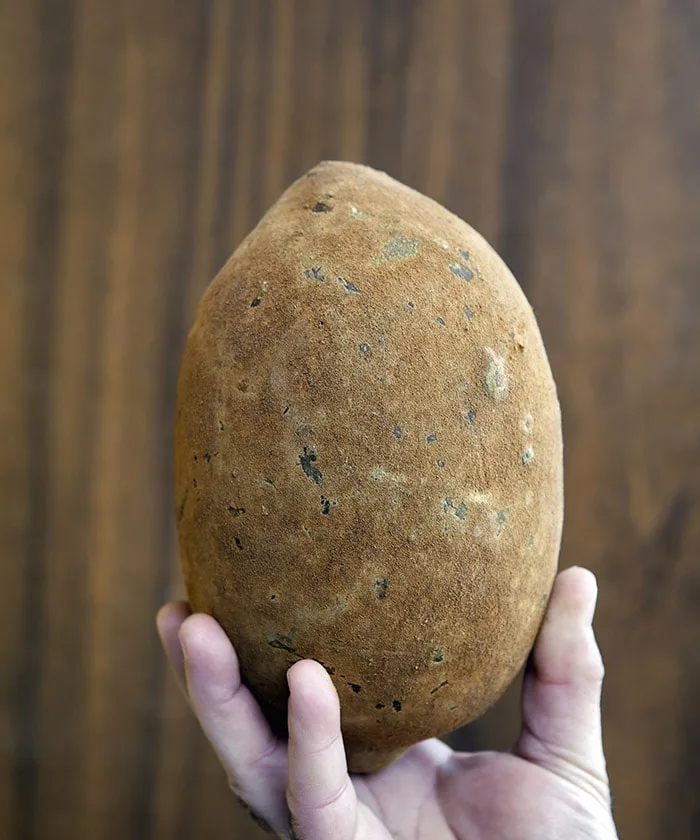
Pronunciation: kuh-puh-ah-ssuh
A tropical rainforest tree related to cocoa, cupuaçu is produced mainly in the north of Brazil.
Because its taste is similar to chocolate, most Brazilians really enjoy eating this fruit or simply drinking its juice. It’s delicious.
Cupuaçu is rich in vitamin C and phosphorus, and it’s widely used in cosmetics products for its antioxidant properties.
Pineapple (Ananas comosus) – Portuguese: abacaxi
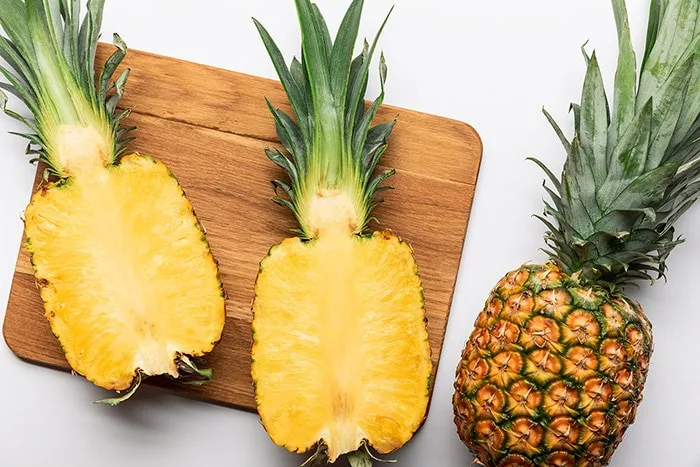
Pronunciation: ah-bah-kah-chee
Yes, pineapple is a typical Brazilian fruit. In fact, it’s considered the national fruit of Brazil.
I know you have probably had this sweet and juicy fruit before, but I thought it would be a cool fun fact to share its origins with you.
High in vitamin C, pineapple is the most economically significant plant in the family Bromeliaceae.
Cashew apple (Anacardium occidentale) – Portuguese: caju
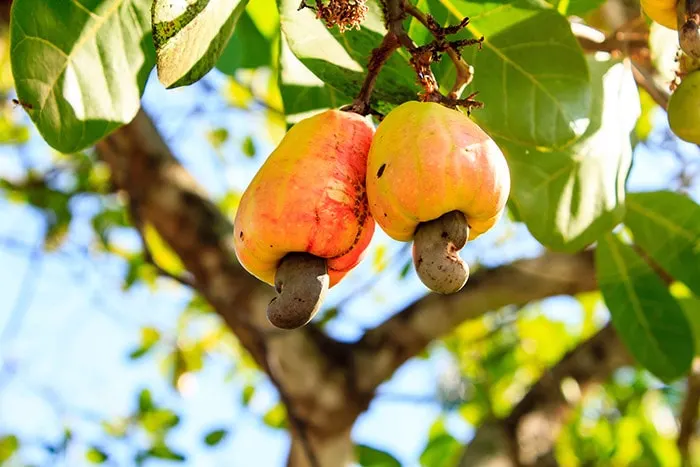
Pronunciation: kah-juh
You’ve probably heard or eaten cashew nuts before, but the nut isn’t the only fruit of the cashew tree.
Or better put, the nut is a part of the cashew fruit.
The other part of the fruit is called cashew apple, but it resembles a red pear.
The cashew apple is high in vitamin C and makes a tasty juice as well as a popular cocktail of Brazil, caju amigo. It tastes sweet and a little acidic. It’s delicious!
Jabuticaba (Plinia cauliflora)
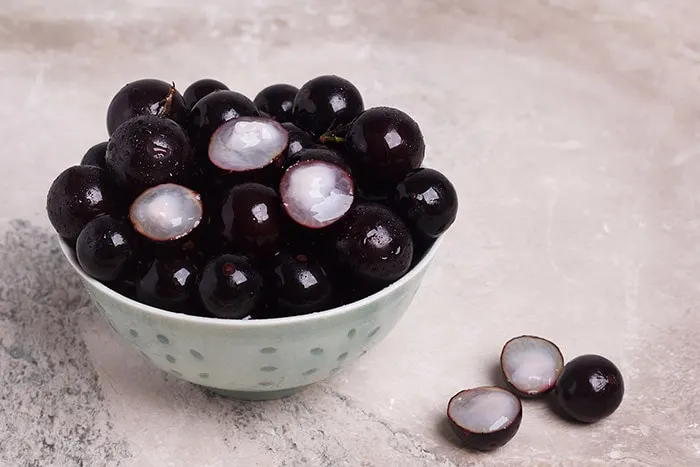
Pronunciation: jah-buh-tee-kah-bah
A rather unusual fruit, jabuticaba blossom of the trunk of its tree. And because this grape-like fruit is deep purple, the jabuticaba tree looks covered in pimples when it’s fully in season.
This Brazilian fruit has a sweet fleshy pulp that contains several seeds. We usually eat the fruit fresh or prepare jams, liqueurs, and baked goods with it.
It is low in calories and carbohydrates and is rich in nutrients such as vitamin C, vitamin E, magnesium, phosphorus, and zinc.
Passion fruit – (Passiflora edulis) Portuguese: maracujá
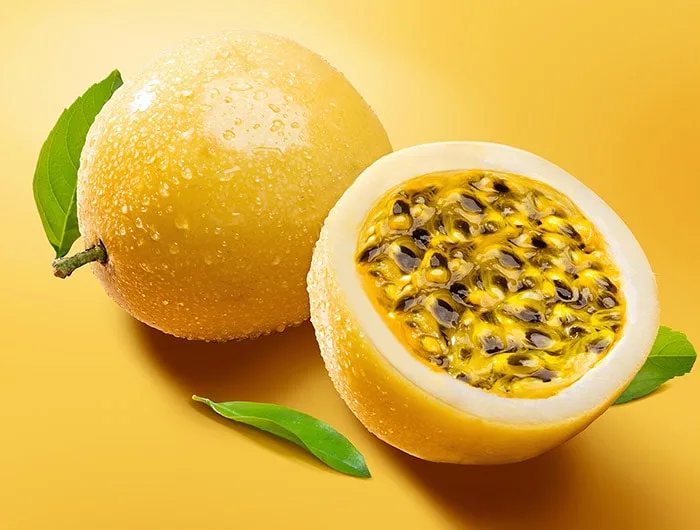
Pronunciation: mah-rah-kuh-jah
Passion fruit is originally from Brazil, and it’s widely used to prepare mousses, sauces, juices, and many desserts.
I remember my sister used to prepare a vitamina with it. Vitamina is a Brazilian drink, and you can prepare it by mixing the passion fruit with milk and sugar in the blender. We would drink that before going to bed.
She used to do that because it is believed to be a natural tranquilizer. The fruit is also rich in vitamins A, C, and B complex properties.
Pitanga (Eugenia uniflora)
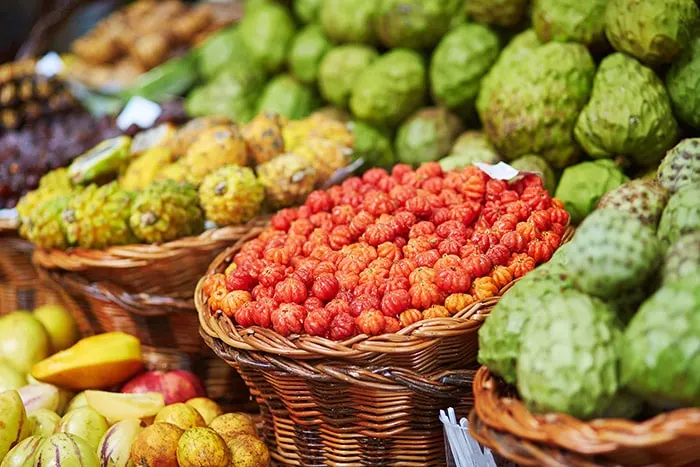
Pronunciation: pee-tahn-gah
Pitanga is a little berry that looks like a cherry and grows in the south of Brazil.
With a pleasant taste, ranging from sweet to sour, Pitanga is a versatile fruit. That’s because it can be consumed raw or used to prepare pulps, juices, ice creams, popsicles, sweets, liqueurs, and even fermented.
Like other native Brazilian fruits, Pitanga is also an ingredient in sophisticated savory dishes and mouth-watering desserts.
The fruit is also a rich source of vitamins C and A and the minerals calcium, iron, and phosphorus. Besides, Pitanga is also a low energy food, 3.5oz (100g) of fruit contain only 41 calories.
Pitomba (Talisia esculenta)
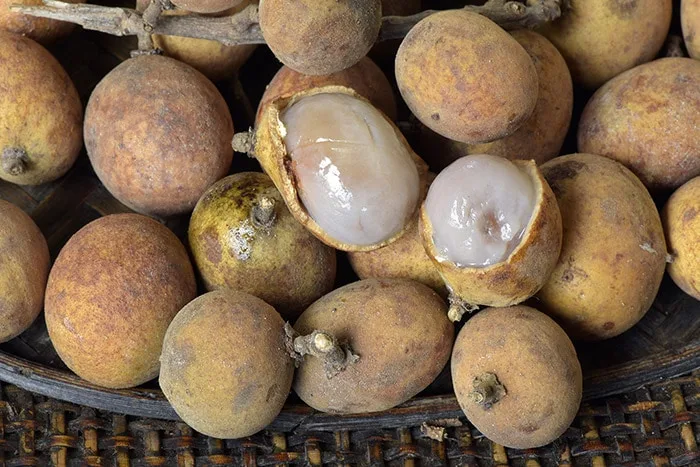
Pronunciation: pee-tom-bah
Pitomba is a tree native to the Amazon basin. It is a member of the Sapindaceae family, the same as guarana.
This fruit of Brazil is found in local markets throughout the country. It has a coloration that ranges from orange to brown, and its sweet and sour pulp is comparable to an apricot.
Pitomba is rich in vitamin C and is often eaten raw or in jelly.
Buriti (Mauritia flexuosa)
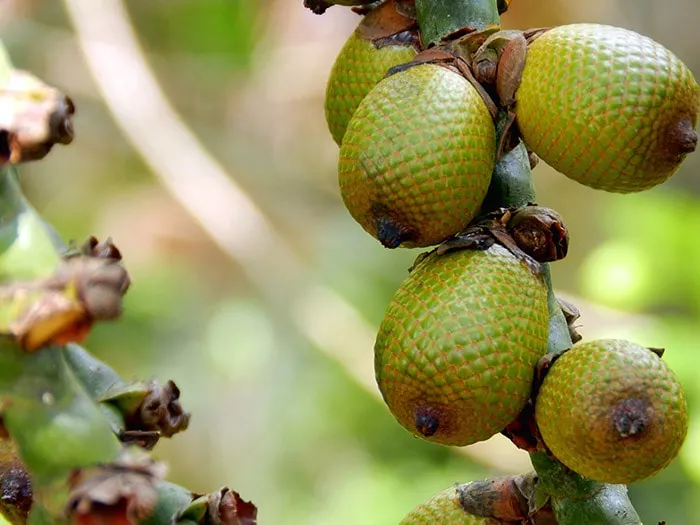
Pronunciation: buh-ree-tee
The buriti flourishes in a palm tree in the tropical region of the Amazon. The husk of the buriti in textured and dark brown-reddish.
The flesh inside is similar to a mango, and the edible nut inside is the tree’s seed.
Because buriti is rich in vitamins A and C, the plant has been used to produce natural oils for skin.
Açaí (Euterpe oleracea)
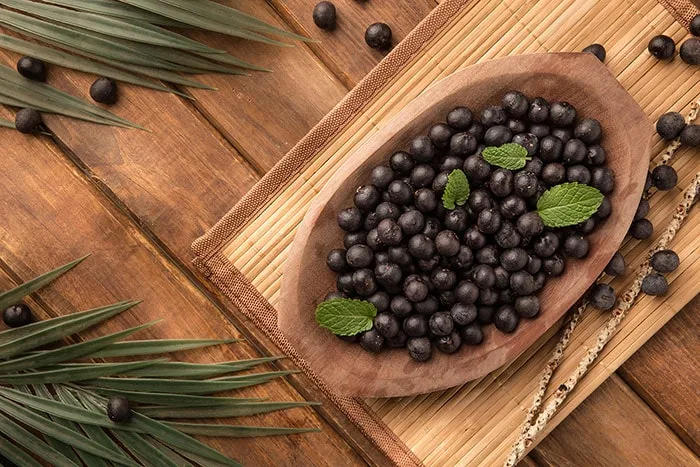
Pronunciation: ah-sigh-ee
Açai berries are a fruit native to the Amazon Rainforest in South America.
This grape-like fruit has a deep purple color, and if you haven’t had an açai bowl yet, it tastes like a blend of berry and cocoa with a slight metallic aftertaste.
Because of its antioxidants and fibers, açai is considered a superfood with benefits ranging from improved skin appearance to weight loss.
Final words on fruits of Brazil
Most fruits of Brazil have tropical characteristics and fleshy pulp.
And while it might be difficult to find most of the Brazilian fruits and vegetables abroad, it is worth trying because they are not only tasty but also rich in several vitamins and minerals.
If you would like to learn more about Brazil, be sure to read up the translation of the national anthem, the national flag, and the map of Brazil.


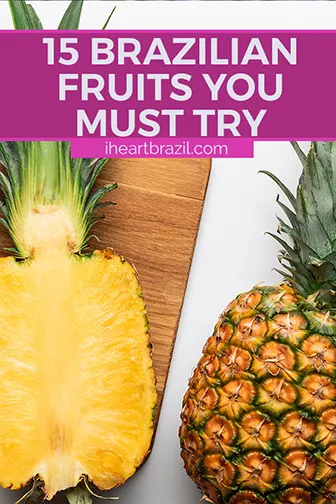
L.
Wednesday 19th of July 2023
If you’re living somewhere nearby an Asian supermarket, you will find a great variety of fruits that you may think you will only find in Brazil itself and may be regional as well. Try any of the so called “Mart” such as HMart. Don’t hesitate in entering and browse around. They might be written in another language but it taste the same, whether fresh or frozen. Pay attention at different cultures and people you see Shopping in different places such as Latino markets as well. Why not try an Indian market? Remember, Brazil is not the only tropical country in the world. There are many places that share similar forests and climate. Regarding açaí, it’s well known by people that are into fitness, vegetarians, vegans to name a few places out of Brazil you will find consumption of “superfood”.
Erik
Tuesday 1st of February 2022
Hello,
I heard that these fruits are like superfruits and works well in a smoothie.
Bacuri Tapereba Cupuacu
Terryn Smith
Tuesday 21st of December 2021
Do you have any recommendations of farms, tours and/or classes that include GUAVA as a key ingredient to learn about?
Bruna
Wednesday 22nd of December 2021
Hi Terryn,
Thanks for reaching out! The only tour I know on a guava farm is in Valinhos, Sao Paulo, which is part of the Fruits Circuit.
In Valinhos, visitors can join a tour through the farm with the owners and see many more fruits along the way. However, I’m not sure it can be done in English. I hope it helps!
Emiliano
Sunday 18th of July 2021
Thank you for all these beautiful pics and info that brings out my childhood as a Brazilian. Sadly here in Massachusetts we’re only able to get our hands on few of them. I would love to find a reliable source for the majority of these beautiful fruits. Ty all
Alex
Friday 27th of August 2021
I think tropical fruit are the best of the fruit tree world.Some definitely survive where I live but I believe Brazil’s climate a bit better.Looking after the Amazon is the key
Bruna
Monday 2nd of August 2021
Hi Emiliano, I must admit it isn't easy to find them here in the Netherlands too (when I'm able to find them at all). So I definitely sympathize with you! Anyway, thanks for commenting!
Ben Louis
Sunday 28th of March 2021
Like most fruits, they are seasonal Hmmm wonder if you can help buying one of the fruits listed to me ?
Cupuacu
Bruna
Saturday 3rd of April 2021
Hi Ben, yes they are seasonal. The cupuacu's seasonality is from October through June, but getting the fruit outside of Brazil might be challenging. This seller on Amazon sells the frozen puree: https://amzn.to/3dxUssb I hope it helps!